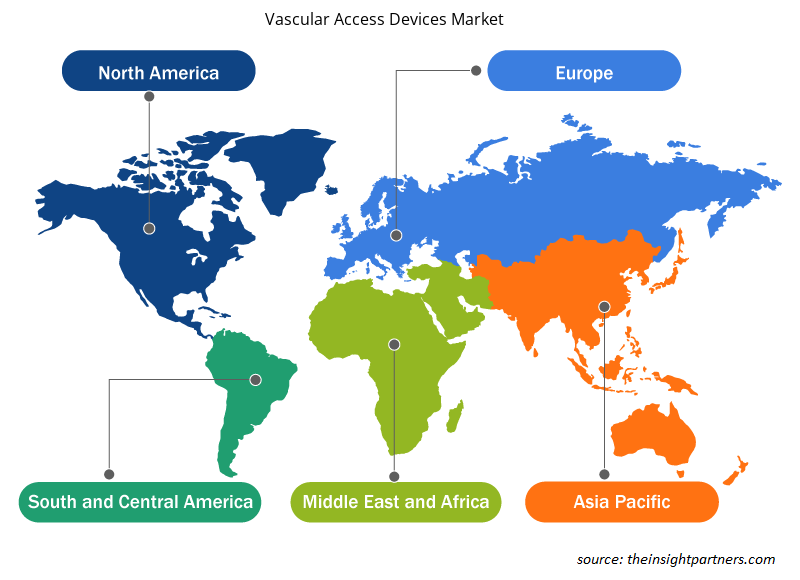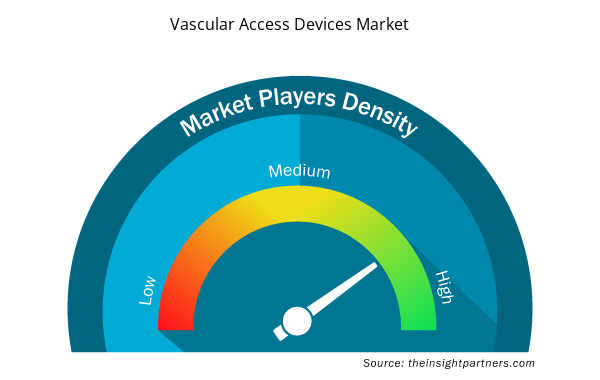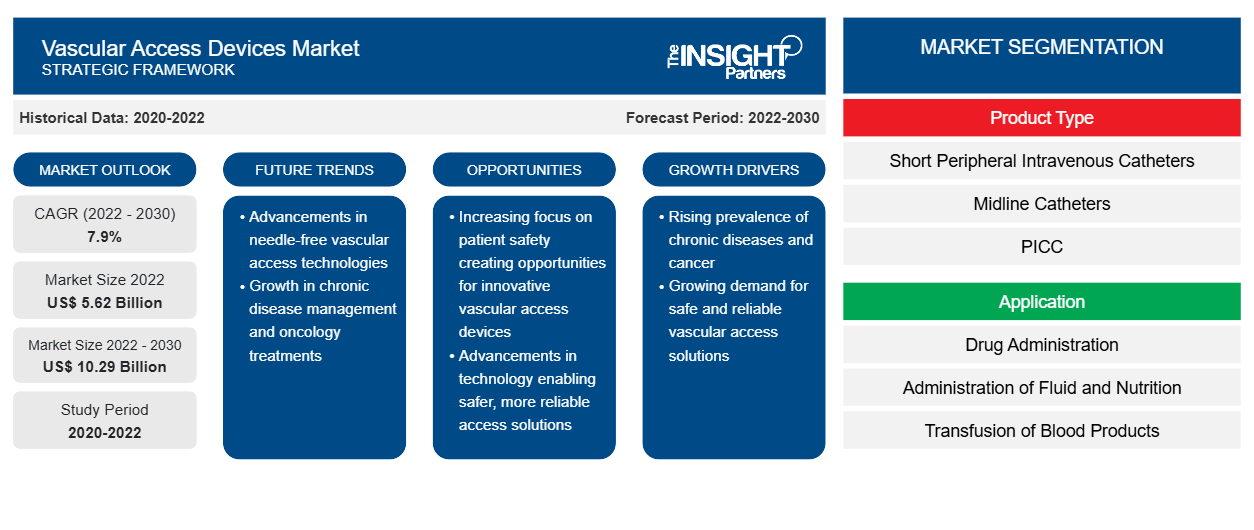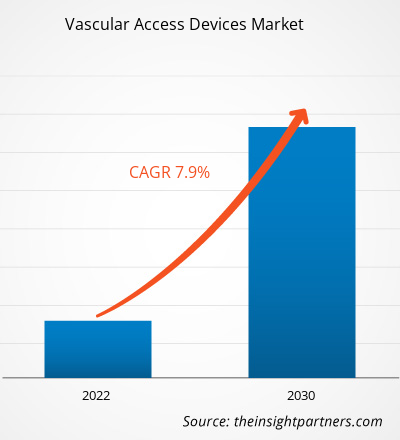[Forschungsbericht] Der Markt für Gefäßzugangsgeräte wurde im Jahr 2022 auf 5,62 Milliarden US-Dollar geschätzt und soll bis 2030 10,29 Milliarden US-Dollar erreichen. Für den Zeitraum 2022–2030 wird eine durchschnittliche jährliche Wachstumsrate (CAGR) von 7,9 % erwartet.
Markteinblicke und Analystenansichten:
Gefäßzugangsgeräte werden an einer Reihe anatomischer Stellen platziert, um Zugang zur oberen oder unteren Hohlvene zu erhalten – Vena jugularis interna, Vena subclavia, Vena jugularis externa und Vena femoralis. Das wachsende Marktvolumen für Gefäßzugangsgeräte wird durch die steigende Prävalenz chronischer Krankheiten und den steigenden Bedarf an Chemotherapieverfahren vorangetrieben. Darüber hinaus treiben strategische Initiativen von Unternehmen, um auf dem Markt wettbewerbsfähig zu bleiben, das Marktwachstum voran. Ein deutlicher Anstieg der Verwendung von KI-gestützten robotergestützten Venenzugangsgeräten wird im Prognosezeitraum wahrscheinlich neue Markttrends für Gefäßzugangsgeräte mit sich bringen.
Wachstumstreiber und Herausforderungen:
Chemotherapie ist eine primäre oder adjuvante Behandlung, die durch die Verabreichung starker Medikamente zum Schrumpfen oder zur Beseitigung von Tumoren eingesetzt wird. Die steigende Zahl von Krebserkrankungen treibt daher die Nachfrage nach Chemotherapieverfahren an. Nach Schätzungen der Internationalen Agentur für Krebsforschung (IARC) wurden im Jahr 2020 weltweit 19,3 Millionen neue Krebsfälle gemeldet und etwa 10 Millionen Menschen starben aufgrund der Krankheit. Laut dem National Cancer Registry (NCR) wurden in Südafrika im Jahr 2020 etwa 110.000 neue Krebsfälle diagnostiziert, mit über 56.000 krebsbedingten Todesfällen. Darüber hinaus wird die Krankheitslast in den kommenden Jahrzehnten voraussichtlich zunehmen. Die Zahl der neuen Krebsfälle wird bis 2030 bzw. 2040 auf 138.000 bzw. 175.000 steigen, während die krebsbedingte Mortalität in den genannten Jahren auf 73.000 bzw. 94.000 steigen wird. Die steigende Prävalenz von Krebs treibt also das Wachstum des Marktes für Gefäßzugangsgeräte voran.
Passen Sie diesen Bericht Ihren Anforderungen an
Sie erhalten kostenlos individuelle Anpassungen an jedem Bericht, einschließlich Teilen dieses Berichts oder einer Analyse auf Länderebene, eines Excel-Datenpakets sowie tolle Angebote und Rabatte für Start-ups und Universitäten.
- Holen Sie sich die wichtigsten Markttrends aus diesem Bericht.Dieses KOSTENLOSE Beispiel umfasst eine Datenanalyse von Markttrends bis hin zu Schätzungen und Prognosen.
Berichtssegmentierung und -umfang:
Die Marktanalyse für Gefäßzugangsgeräte wurde unter Berücksichtigung der folgenden Segmente durchgeführt: Produkttyp, Anwendung, Einführweg, Endbenutzer und Geografie. Der Markt ist nach Produkttyp in kurze periphere intravenöse Katheter, Midline-Katheter, PICC (peripher eingeführte zentrale Katheter), zentrale Katheter , implantierbare Ports und Zubehör unterteilt. Der Markt für das Segment der zentralen Katheter ist weiter segmentiert in CICC (zentral eingeführter zentraler Katheter), FICC (femoral eingeführter zentraler Katheter) und Sonstiges. Basierend auf der Anwendung ist der Markt für Gefäßzugangsgeräte in Arzneimittelverabreichung, Verabreichung von Flüssigkeit und Nahrung, Transfusion von Blutprodukten und Sonstiges segmentiert. Basierend auf dem Einführweg ist der Markt in subkutan und intravenös unterteilt. Basierend auf den Endbenutzern ist der Markt in Krankenhäuser und Kliniken, ambulante chirurgische Zentren und Sonstiges segmentiert. Der Umfang des Marktberichts zu Gefäßzugangsgeräten umfasst Nordamerika (USA, Kanada und Mexiko), Europa (Spanien, Großbritannien, Deutschland, Frankreich, Italien und das übrige Europa), den asiatisch-pazifischen Raum (Südkorea, China, Japan, Indien, Australien und den restlichen asiatisch-pazifischen Raum), den Nahen Osten und Afrika (Südafrika, Saudi-Arabien, die Vereinigten Arabischen Emirate und den restlichen Nahen Osten und Afrika) sowie Süd- und Mittelamerika (Brasilien, Argentinien und den Rest von Süd- und Mittelamerika).
Segmentanalyse:
Der Markt für Gefäßzugangsgeräte ist nach Produkttyp in kurze periphere intravenöse Katheter, Mittellinienkatheter, PICC (peripher eingeführte zentrale Katheter), zentrale Katheter, implantierbare Ports und Zubehör unterteilt. Der Markt für das Segment der zentralen Katheter ist in CICC (zentral eingeführter zentraler Katheter), FICC (femoral eingeführter zentraler Katheter) und andere unterteilt. Im Jahr 2022 wird derDas Segment der kurzen peripheren intravenösen Katheter hatte den größten Marktanteil bei Gefäßzugangsgeräten und es wird erwartet, dass dasselbe Segment im Zeitraum 2022–2030 die höchste durchschnittliche jährliche Wachstumsrate (CAGR) verzeichnet.
Basierend auf der Anwendung ist der Markt für Gefäßzugangsgeräte in Arzneimittelverabreichung, Verabreichung von Flüssigkeit und Nahrung, Transfusion von Blutprodukten und andere unterteilt. Im Jahr 2022 hatte das Segment Arzneimittelverabreichung den größten Anteil und wird voraussichtlich zwischen 2022 und 2030 die höchste durchschnittliche jährliche Wachstumsrate verzeichnen.
Basierend auf der Einführmethode wird der Markt für Gefäßzugangsgeräte in subkutane und intravenöse unterteilt. Das intravenöse Segment hatte 2022 einen größeren Marktanteil und wird voraussichtlich zwischen 2022 und 2030 eine höhere durchschnittliche jährliche Wachstumsrate verzeichnen.
Nach Endverbraucher ist der Markt in Krankenhäuser und Kliniken, ambulante chirurgische Zentren und andere segmentiert. Der Markt für Gefäßzugangsgeräte für das Segment Krankenhäuser und Kliniken wird voraussichtlich zwischen 2022 und 2030 wachsen.
Regionale Analyse:
Nordamerika leistet den größten Beitrag zum weltweiten Wachstum des Marktes für Gefäßzugangsgeräte. Der asiatisch-pazifische Raum wird voraussichtlich zwischen 2022 und 2030 die höchste durchschnittliche jährliche Wachstumsrate (CAGR) auf dem Markt verzeichnen. Nordamerika hatte 2022 den größten Anteil am Weltmarkt, was auf die zunehmende Verbreitung chronischer Erkrankungen, die zunehmende geriatrische Bevölkerung, die Präsenz wichtiger Marktteilnehmer, die an neuen und bestehenden Produktentwicklungen beteiligt sind, und den zunehmenden technologischen Fortschritt zurückzuführen ist. In Nordamerika hatten die USA 2022 den größten Marktanteil.
Regionale Einblicke in den Markt für Gefäßzugangsgeräte
Die regionalen Trends und Faktoren, die den Markt für Gefäßzugangsgeräte während des Prognosezeitraums beeinflussen, wurden von den Analysten von Insight Partners ausführlich erläutert. In diesem Abschnitt werden auch die Marktsegmente und die Geografie für Gefäßzugangsgeräte in Nordamerika, Europa, im asiatisch-pazifischen Raum, im Nahen Osten und Afrika sowie in Süd- und Mittelamerika erörtert.

- Erhalten Sie regionale Daten zum Markt für Gefäßzugangsgeräte
Umfang des Marktberichts über Gefäßzugangsgeräte
| Berichtsattribut | Details |
|---|---|
| Marktgröße im Jahr 2022 | 5,62 Milliarden US-Dollar |
| Marktgröße bis 2030 | 10,29 Milliarden US-Dollar |
| Globale CAGR (2022 - 2030) | 7,9 % |
| Historische Daten | 2020-2022 |
| Prognosezeitraum | 2022–2030 |
| Abgedeckte Segmente | Nach Produkttyp
|
| Abgedeckte Regionen und Länder | Nordamerika
|
| Marktführer und wichtige Unternehmensprofile |
|
Marktteilnehmerdichte für Gefäßzugangsgeräte: Auswirkungen auf die Geschäftsdynamik verstehen
Der Markt für Gefäßzugangsgeräte wächst rasant, angetrieben durch die steigende Endverbrauchernachfrage aufgrund von Faktoren wie sich entwickelnden Verbraucherpräferenzen, technologischen Fortschritten und einem größeren Bewusstsein für die Vorteile des Produkts. Mit steigender Nachfrage erweitern Unternehmen ihr Angebot, entwickeln Innovationen, um die Bedürfnisse der Verbraucher zu erfüllen, und nutzen neue Trends, was das Marktwachstum weiter ankurbelt.
Die Marktteilnehmerdichte bezieht sich auf die Verteilung der Firmen oder Unternehmen, die in einem bestimmten Markt oder einer bestimmten Branche tätig sind. Sie gibt an, wie viele Wettbewerber (Marktteilnehmer) in einem bestimmten Marktraum im Verhältnis zu seiner Größe oder seinem gesamten Marktwert präsent sind.
Die wichtigsten auf dem Markt für Gefäßzugangsgeräte tätigen Unternehmen sind:
- Teleflex Inc
- BD
- B. Braun SE
- Terumo Medical Corporation
- Medtronic
Haftungsausschluss : Die oben aufgeführten Unternehmen sind nicht in einer bestimmten Reihenfolge aufgeführt.

- Überblick über die wichtigsten Akteure auf dem Markt für Gefäßzugangsgeräte
Branchenentwicklungen und zukünftige Chancen:
Die Marktprognose für Gefäßzugangsgeräte wird auf der Grundlage verschiedener sekundärer und primärer Forschungsergebnisse wie wichtiger Unternehmensveröffentlichungen, Verbandsdaten und Datenbanken geschätzt. Laut den von den wichtigsten Marktteilnehmern veröffentlichten Pressemitteilungen sind im Folgenden einige Strategien aufgeführt:
- Im November 2023 brachte BD (Becton, Dickinson and Company) eine neue nadelfreie Blutentnahmetechnologie auf den Markt, die mit integrierten Kathetern kompatibel ist und dazu beiträgt, die Vision des Unternehmens von einem „Krankenhausaufenthalt mit nur einem Stich“ zu verwirklichen. Das nadelfreie Blutentnahmegerät PIVO Pro verfügt über Designverbesserungen, um die Kompatibilität mit integrierten und langen peripheren IV-Kathetern zu erreichen, zu denen auch das neue geschlossene Nexiva-IV-Kathetersystem mit NearPort IV-Zugang gehört.
- Im Mai 2023 brachte Teleflex Inc. zwei neue Geräte auf den Markt – das Arrow VPS Rhythm DLX-Gerät und das NaviCurve Stylet –, die die PICC-Einführungsverfahren verbessern und das Komplikationsrisiko verringern sollen. Das VPS Rhythm DLX-Gerät liefert Echtzeitinformationen zur Position der Katheterspitze, indem es die elektrische Herzaktivität des Patienten nutzt. Das NaviCurve Stylet verfügt über eine anatomische Kurve und eine flexible Spitze, die sich automatisch an die Anatomie des Patienten anpasst, um das Vorschieben des PICC in die obere Hohlvene (SVC) für eine erfolgreiche Einführung zu verbessern.
Wettbewerbslandschaft und Schlüsselunternehmen:
Teleflex Inc, BD, B. Braun SE, Terumo Medical Corporation, Medtronic, Fresenius Kabi, Baxter, Vygon SAS, Kimal und Access Vascular Inc gehören zu den prominenten Akteuren, die im Marktbericht für Gefäßzugangsgeräte vorgestellt werden. Darüber hinaus wurden im Rahmen der Studie mehrere andere Akteure untersucht und analysiert, um einen ganzheitlichen Überblick über den Markt und sein Ökosystem zu erhalten. Diese Unternehmen konzentrieren sich auf geografische Expansionen und die Einführung neuer Produkte, um die wachsende Nachfrage von Verbrauchern auf der ganzen Welt zu erfüllen und ihre Produktpalette in Spezialportfolios zu erweitern. Ihre globale Präsenz ermöglicht es ihnen, einen großen Kundenstamm zu bedienen und so die Marktexpansion zu erleichtern.
- Historische Analyse (2 Jahre), Basisjahr, Prognose (7 Jahre) mit CAGR
- PEST- und SWOT-Analyse
- Marktgröße Wert/Volumen – Global, Regional, Land
- Branche und Wettbewerbsumfeld
- Excel-Datensatz



Report Coverage
Revenue forecast, Company Analysis, Industry landscape, Growth factors, and Trends

Segment Covered
This text is related
to segments covered.

Regional Scope
North America, Europe, Asia Pacific, Middle East & Africa, South & Central America

Country Scope
This text is related
to country scope.
Häufig gestellte Fragen
Based on geography, the vascular access devices market is segmented into North America (the US, Canada, and Mexico), Europe (the UK, Germany, France, Italy, Spain, and the Rest of Europe), Asia Pacific (China, Japan, India, South Korea, Australia, and the Rest of Asia Pacific), the Middle East & Africa (the UAE, Saudi Arabia, South Africa, and Rest of the Middle East & Africa), and South & Central America (Brazil, Argentina, and the Rest of South & Central America). North America is the largest contributor to the growth of the global vascular access devices market. Asia Pacific is expected to register the highest CAGR in the vascular access devices market during 2022–2030.
The vascular access devices market majorly consists of the players such Teleflex Inc, BD, B. Braun SE, Terumo Medical Corporation, Medtronic, Fresenius Kabi, Baxter, Vygon SAS, Kimal, and Access Vascular Inc
The vascular access devices market, by treatment type, is segmented into short peripheral intravenous catheters, midline catheters, PICC (peripherally inserted central catheters), central catheter, implantable ports, and accessories. Central catheter is further divided into CICC (centrally inserted central catheter), FICC (femorally inserted central catheter), and others. In 2022, the short peripheral intravenous catheter segment held the largest vascular access devices market share and is expected to record the highest CAGR during 2022–2030.
Based on application, the market is segmented into drug administration, administration of fluid & nutrition, transfusion of blood products, and others. In 2022, the drug administration segment held the largest vascular access devices market share and is projected to record the highest CAGR during 2022–2030.
Based on route of insertion, the market is bifurcated into subcutaneous and intravenous. The intravenous segment held a larger share of the vascular access devices market in 2022 and is anticipated to record a higher CAGR during 2022–2030.
Based on end user, the market is divided into hospitals and clinics, ambulatory surgical center, and others. The vascular access devices market size for the hospitals and clinics segment is likely to surge during 2022–2030.
Vascular access devices are placed using a number of anatomic sites to access the superior or inferior vena cava: the internal jugular vein, subclavian vein, external jugular vein, and femoral vein. The growing market size is attributed to the increasing prevalence of chronic diseases and increasing chemotherapy procedures. In addition, strategic initiatives by companies to stay competitive in the market are fueling the market growth. Significant increase in use of AI-enabled robotic venous access devices is likely to bring new vascular access devices market trends during the forecast period.
The increasing cases of chronic disorders and growing demand of chemotherapy procedures are factors predominently driving the vascular access devices market size. However, the high cost associated with placement of vascular access devices hinders the market growth.
Trends and growth analysis reports related to Life Sciences : READ MORE..
The List of Companies - Vascular Access Devices Market
- Teleflex Inc
- BD
- B. Braun SE
- Terumo Medical Corporation
- Medtronic
- Fresenius Kabi
- Baxter
- Vygon SAS
- Kimal
- Access Vascular Inc
The Insight Partners performs research in 4 major stages: Data Collection & Secondary Research, Primary Research, Data Analysis and Data Triangulation & Final Review.
- Data Collection and Secondary Research:
As a market research and consulting firm operating from a decade, we have published and advised several client across the globe. First step for any study will start with an assessment of currently available data and insights from existing reports. Further, historical and current market information is collected from Investor Presentations, Annual Reports, SEC Filings, etc., and other information related to company’s performance and market positioning are gathered from Paid Databases (Factiva, Hoovers, and Reuters) and various other publications available in public domain.
Several associations trade associates, technical forums, institutes, societies and organization are accessed to gain technical as well as market related insights through their publications such as research papers, blogs and press releases related to the studies are referred to get cues about the market. Further, white papers, journals, magazines, and other news articles published in last 3 years are scrutinized and analyzed to understand the current market trends.
- Primary Research:
The primarily interview analysis comprise of data obtained from industry participants interview and answers to survey questions gathered by in-house primary team.
For primary research, interviews are conducted with industry experts/CEOs/Marketing Managers/VPs/Subject Matter Experts from both demand and supply side to get a 360-degree view of the market. The primary team conducts several interviews based on the complexity of the markets to understand the various market trends and dynamics which makes research more credible and precise.
A typical research interview fulfils the following functions:
- Provides first-hand information on the market size, market trends, growth trends, competitive landscape, and outlook
- Validates and strengthens in-house secondary research findings
- Develops the analysis team’s expertise and market understanding
Primary research involves email interactions and telephone interviews for each market, category, segment, and sub-segment across geographies. The participants who typically take part in such a process include, but are not limited to:
- Industry participants: VPs, business development managers, market intelligence managers and national sales managers
- Outside experts: Valuation experts, research analysts and key opinion leaders specializing in the electronics and semiconductor industry.
Below is the breakup of our primary respondents by company, designation, and region:

Once we receive the confirmation from primary research sources or primary respondents, we finalize the base year market estimation and forecast the data as per the macroeconomic and microeconomic factors assessed during data collection.
- Data Analysis:
Once data is validated through both secondary as well as primary respondents, we finalize the market estimations by hypothesis formulation and factor analysis at regional and country level.
- Macro-Economic Factor Analysis:
We analyse macroeconomic indicators such the gross domestic product (GDP), increase in the demand for goods and services across industries, technological advancement, regional economic growth, governmental policies, the influence of COVID-19, PEST analysis, and other aspects. This analysis aids in setting benchmarks for various nations/regions and approximating market splits. Additionally, the general trend of the aforementioned components aid in determining the market's development possibilities.
- Country Level Data:
Various factors that are especially aligned to the country are taken into account to determine the market size for a certain area and country, including the presence of vendors, such as headquarters and offices, the country's GDP, demand patterns, and industry growth. To comprehend the market dynamics for the nation, a number of growth variables, inhibitors, application areas, and current market trends are researched. The aforementioned elements aid in determining the country's overall market's growth potential.
- Company Profile:
The “Table of Contents” is formulated by listing and analyzing more than 25 - 30 companies operating in the market ecosystem across geographies. However, we profile only 10 companies as a standard practice in our syndicate reports. These 10 companies comprise leading, emerging, and regional players. Nonetheless, our analysis is not restricted to the 10 listed companies, we also analyze other companies present in the market to develop a holistic view and understand the prevailing trends. The “Company Profiles” section in the report covers key facts, business description, products & services, financial information, SWOT analysis, and key developments. The financial information presented is extracted from the annual reports and official documents of the publicly listed companies. Upon collecting the information for the sections of respective companies, we verify them via various primary sources and then compile the data in respective company profiles. The company level information helps us in deriving the base number as well as in forecasting the market size.
- Developing Base Number:
Aggregation of sales statistics (2020-2022) and macro-economic factor, and other secondary and primary research insights are utilized to arrive at base number and related market shares for 2022. The data gaps are identified in this step and relevant market data is analyzed, collected from paid primary interviews or databases. On finalizing the base year market size, forecasts are developed on the basis of macro-economic, industry and market growth factors and company level analysis.
- Data Triangulation and Final Review:
The market findings and base year market size calculations are validated from supply as well as demand side. Demand side validations are based on macro-economic factor analysis and benchmarks for respective regions and countries. In case of supply side validations, revenues of major companies are estimated (in case not available) based on industry benchmark, approximate number of employees, product portfolio, and primary interviews revenues are gathered. Further revenue from target product/service segment is assessed to avoid overshooting of market statistics. In case of heavy deviations between supply and demand side values, all thes steps are repeated to achieve synchronization.
We follow an iterative model, wherein we share our research findings with Subject Matter Experts (SME’s) and Key Opinion Leaders (KOLs) until consensus view of the market is not formulated – this model negates any drastic deviation in the opinions of experts. Only validated and universally acceptable research findings are quoted in our reports.
We have important check points that we use to validate our research findings – which we call – data triangulation, where we validate the information, we generate from secondary sources with primary interviews and then we re-validate with our internal data bases and Subject matter experts. This comprehensive model enables us to deliver high quality, reliable data in shortest possible time.


 Holen Sie sich ein kostenloses Muster für diesen Bericht
Holen Sie sich ein kostenloses Muster für diesen Bericht